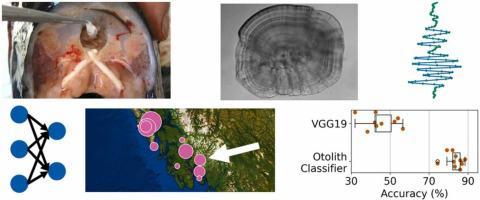Fisheries Research ( IF 2.4 ) Pub Date : 2022-03-08 , DOI: 10.1016/j.fishres.2022.106295 Chandler E. Kemp , Susan K. Doherty

|
We present a computer vision method for identifying and reading hatchery marks in salmon otoliths. Synthetic otolith marks are used at hundreds of hatcheries throughout the Pacific Rim to record the release location of salmon. Each year, human readers examine hundreds of thousands of otolith samples to identify the marks in captured salmon. The data guide hatchery investments and inform dynamic management practices that maximize allowable catch while preserving wild-hatched populations. However, the method is limited by the time required to process otoliths, the inability to distinguish between wild and un-marked hatchery fish, and in some cases classification processes are limited by the subjective decisions of human readers. Automated otolith reading using computer vision has the potential to improve on all three of these limitations. We tested the classification accuracy of transfer learning using previously published deep neural networks pretrained with the ImageNet database and compared it to the classification accuracy achieved using shallow networks developed specifically for otolith reading. The shallow networks achieved better classification accuracy with the available training and test sets. In particular, we report a novel otolith classification algorithm that uses two neural networks trained with an adversarial algorithm to achieve 93% classification accuracy between four hatchery marks and unmarked otoliths. The algorithm relies on hemi-section images of the otolith exclusively: no additional biological data are needed. Our work demonstrates a novel technique with modest training requirements that achieves unprecedented accuracy. The method can be easily adopted in existing otolith labs, scaled to accommodate additional marks, and does not require tracking additional information about the fish that the otolith was retrieved from. Future work should determine the value of expanding the training set and applying the algorithm to a more diverse set of otolith marks.
中文翻译:

使用自动耳石读数确定鲑鱼来源
我们提出了一种计算机视觉方法,用于识别和读取鲑鱼耳石中的孵化标记。整个环太平洋地区的数百个孵化场使用合成耳石标记来记录鲑鱼的释放位置。每年,人类读者都会检查数十万个耳石样本,以识别捕获的鲑鱼中的标记。这些数据指导孵化场投资并为动态管理实践提供信息,以最大限度地提高允许捕捞量,同时保护野生孵化种群。然而,该方法受到处理耳石所需时间的限制,无法区分野生和未标记的孵化鱼,并且在某些情况下,分类过程受到人类读者主观决定的限制。使用计算机视觉的自动耳石读取有可能改善所有这三个限制。我们使用先前发布的使用 ImageNet 数据库预训练的深度神经网络测试了迁移学习的分类准确度,并将其与使用专门为耳石读取开发的浅层网络实现的分类准确度进行了比较。浅层网络利用可用的训练和测试集实现了更好的分类精度。特别是,我们报告了一种新的耳石分类算法,该算法使用两个用对抗算法训练的神经网络,在四个孵化场标记和未标记的耳石之间实现 93% 的分类准确率。该算法完全依赖耳石的半切片图像:不需要额外的生物数据。我们的工作展示了一种具有适度培训要求的新技术,可实现前所未有的准确性。该方法可以很容易地在现有的耳石实验室中采用,缩放以适应额外的标记,并且不需要跟踪有关从耳石中检索到的鱼的额外信息。未来的工作应该确定扩展训练集并将算法应用于更多样化的耳石标记集的价值。


























 京公网安备 11010802027423号
京公网安备 11010802027423号